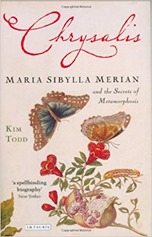 Chrysalis: Maria Sibylla Merian and the Secrets of Metamorphosis by Kim Todd has a self-explanatory title, it is about the life of Maria Sibylla Merian a scientific illustrator who lived 1647-1717, and the life cycle of insects – their metamorphosis.
Chrysalis: Maria Sibylla Merian and the Secrets of Metamorphosis by Kim Todd has a self-explanatory title, it is about the life of Maria Sibylla Merian a scientific illustrator who lived 1647-1717, and the life cycle of insects – their metamorphosis.
“Scientific illustrator” does not feel like the right term for Merian. She actively collected insects, at all stages in their lifecycles to study how they developed. This involved learning how how to nurture the insects. Her illustrations showed the insects through the stages of their lives alongside the plants on which they lived and fed. This is close to a study of ecology which didn’t really gain recognition as an area of study until the early 19th century. In her fifties she spent a couple of years in Surinam where she continued her study of more exotic creatures.
She was born in Frankfurt where she lived until she married and moved to Nuremburg, also in what is now Germany. Her father, Matthäus Merian was an illustrator, as was her stepfather Jacob Marrel, her husband Johann Andreas Graff, was one of Marrel’s apprentices. In 1685 Merian left her husband to go to a religious community in the Netherlands (the Labadists in Wieuwerd) with her mother and two daughters. She left Wieuwerd in 1691 to live in Amsterdam where she stayed until her death in 1717, aside a two year trip to Surinam.
Surinam had been “visited” by Europeans in the 16th century, and the Dutch had gained control of it from the English in the late 17th century. The English got New Amsterdam, now New York, as a quid pro quo. The colony was under the control of the Dutch West India Company and Labadists had been amongst those that gone out to the colony, their stories returning with them to the community at Wieuwerd. Surinam was not unknown land but it was tropical, and the colonial government were keen to get people out to the country to make a more well-rounded society. Merian went there to study insects in the same way as she had done in Europe but was, to some degree foiled by the conditions: deep jungle, rife with disease. Nevertheless her study there led to the publication of her book: Metamorphosis insectorum Surinamensium. I must admit I’m rather tempted by this facsimile.
Merian received a good deal of encouragement from father and stepfather in pursing art but the guild and business systems of the time made it difficult for her to work professionally as an artist. She seems to have got by by forming relationships with a range of nature enthusiasts for whom she carried out commissions, selling her illustrations individually, and trading in specimens for cabinets of curiosities.
She appears to have been remarkably independent for the period. Caroline Herschel lived somewhat later than her in England but her work in astronomy was tied to her brother, William. Similarly her exact contemporary, Elisabeth Hevelius, who had her own reputation as an astronomer was closely coupled to that of her husband.
Merian lived in a time when the study of nature was evolving. People were still seriously asking whether certain forms of life appeared spontaneously (the Royal Society’s cheese mite experiments). Linneas had not yet created his nomenclature for living things. Gentlemen were populating “cabinets of curiosities” but they were disorganised assemblages of artefacts. She was a contemporary of Jan Swammerdam, Antonie van Leeuwenhoek and Robert Hook.
The past can be difficult to understand, the meanings of words can shift quite dramatically. For example, René Antoine Ferchault de Réaumur said “The crocodile is certainly a fierce insect, but I am not in the least disturbed about calling it one!”.
This is all to say that Merian could quite reasonably be described as working at the cutting edge of biology.
Merian is surprisingly well-documented, this seems to be as a result of a couple of factors. Her family were moderately high-profile and as publishers / illustrators naturally left substantial records. She published several books which were reprinted over the next hundred years or so, her illustrations appeared, sometimes unattributed, in other publications. A chunk of her papers were acquired by Peter the Great and ended up in St Petersburgh where they were re-discovered in the 1970s.
Her work seems to have attracted criticism in the early 19th century, on grounds of inaccuracy understandable, since by this time her books were over 100 years old. This criticism was possibly also driven by the changing character of naturalists, they were starting to professionalise, and no doubt also linked to her gender. Many of her male contemporaries had some funny ideas but this is often glossed over.
I enjoyed Chrysalis it covers Merian’s life in some detail whilst bringing in a good flavour of the times in which she lived and the people she interacted with.

